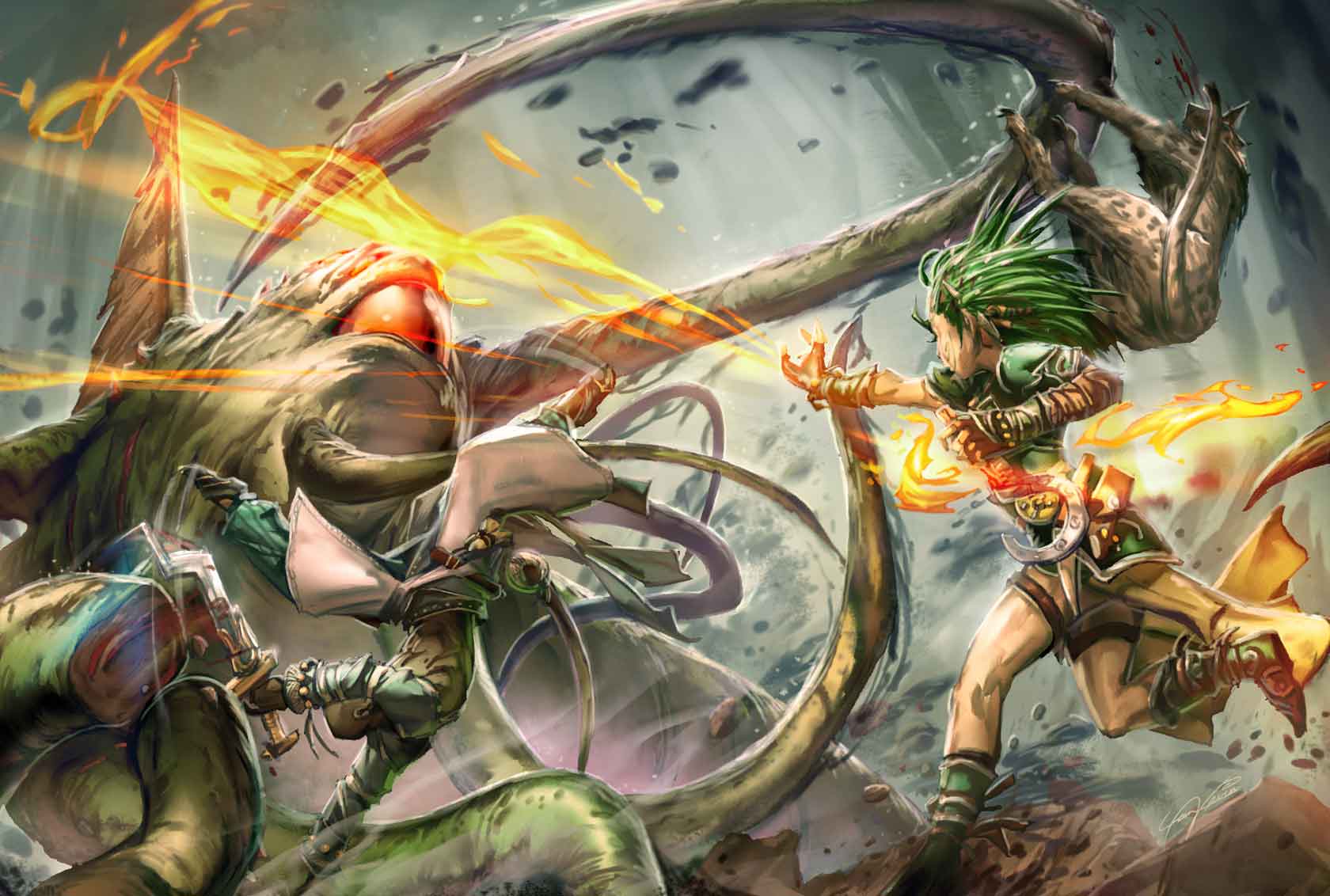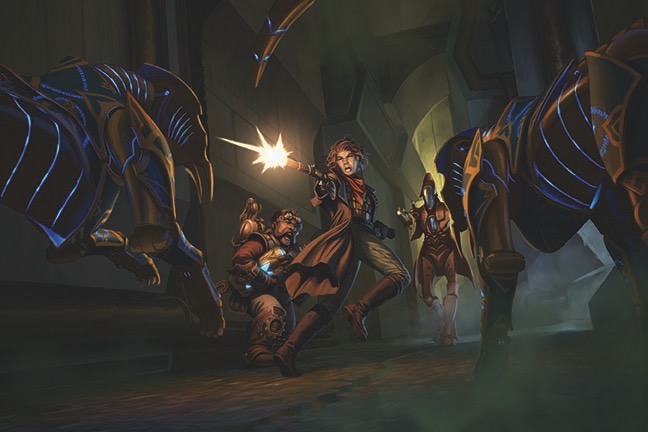Time is a funny thing. You live, you create, you grow, and you look back on your old creations with enough cringe to twist your spine into the shape of a question mark. I am no such exception. In fact, my last article was all about adding content to the Anadi that I regret not thinking of at the time. And now I’ll be going back to redo a mechanic from an entry for this blog that isn’t even a year old. It’s like I’m going through an Any% speedrun for the process of regret.
Hello and welcome to Eldritch Excursion, the blog that knows the lore, shows bad guys the door, and chambers its rounds for full bore. Today we’ll be looking back at my old attempt to mix firearms with magic. It was an attempt I’d call pretty okay-ish, but it was missing that extra little umph I like to put into my work. And I’m going to fix that now, so let’s kick off my alternate-alternate mechanics involving arcane firearms.
Rune Cannons [Rare]
These magically infused firearms act as a means of channeling magical power into powerful shots. Unlike their more commonly available counterpart in runeguns, rune cannons lack their own innate spells and instead rely on specially prepared cartridges that hold individual spells. These cartridges are expendable resources that all have unique design quirks based on the targeting of their spells. Casting fireball with your rune cannon will usually launch the entire cartridge, which explodes on impact, while casting lightning bolt may end with you ejecting a scorched, inert shell from your rune cannon.
Casting a spell from a rune cannon requires you to first spend an action loading a cartridge, similar to loading a firearm. Casting the spell requires the same components, with somatic components replaced by operating the firearm while material components are part of the cartridge’s construction. Verbal components replicated by the mechanisms of the firearm, requiring the wielder to make an action with the auditory and manipulate trait. Spells that normally do not require a saving throw or an attack roll must still be ‘fired’ at their target, and such spells require a spell attack roll against the AC of an unwilling target to affect them. If the attack roll misses, the spell fails and the cartridge is consumed as normal.
No matter how elaborate a rune cannon may appear, they still have the function of a basic firearm. When a rune cannon is created, its creator chooses one type of common firearm to act as the foundation. A rune cannon can be wielded as that type of firearm as normal, or used to cast spells through cartridges. This uses the wielder’s spell DC and spell attack roll bonuses where appropriate. However, thanks to their overlapping fields, any wielder that is at least expert in the appropriate firearm counts as trained when casting spells with a rune cannon.
As with any other kind of firearm, rune cannons can be enhanced with runes. Fundamental runes can also affect the spells cast with rune cannons. A weapon potency rune grants its item bonus too all spell attack rolls made with the rune cannon, but it does not apply on any attack roll that does not target Armor Class. A striking rune amplifies your spells. When you cast a spell from your rune cannon that consumes a cartridge, if the spell deals damage and doesn’t have a duration, you gain a status bonus to that spell’s damage equal to half of the spell’s level. If you have a greater striking rune, it instead deals damage equal to the spell’s level. If you have a major striking rune, it deals damage equal to one and a half times the spell’s level.
Each rune cannon is a priceless tool of its own unique creation, tooled towards a specific magical tradition. A rune cannon made of wood and enchanted stone could be a created for primal magic and would only be able to cast cartridges made for spells on the primal list, for example, while an elaborate rifle made of steel and glass may be attuned to arcane spells.
Despite their unconventional nature, cartridges are functionally similar to scrolls in terms of their cost and difficulty to create. A cartridge is created with a specific spell at a specific level and is consumed when used. A rune cannon cannot cast a spell from a cartridge with a spell level that is more than half the level of the rune cannon (rounded up.)
New Arcane Thesis: Arcane Cannoneer
Through access to exceedingly rare tutelage, dissection of a rune cannon, or deals with shady entities, you have begun to unlock the secret of constructing a rune cannon of your own design. Choose one commonly available firearm worth 10 gp or less. You become proficient in that firearm and gain one for free. That firearm also counts as a rune cannon with a level equal to yours. Since your rune cannon is a prototype that feeds off of your own power, it cannot be used to cast spells by anyone other than you. If your rune cannon is damaged, it is returned to full HP during your daily preparations. If your rune cannon is ever destroyed, you can rebuild it for free with one week of downtime. At 11th level, your proficiency with your chosen firearm is increased to expert.
Instead of preparing spells like normal, you weave magic to infuse temporary cartridges from the spells in your spell book. You may infuse one cartridge for each appropriate spell slot. For example, a 1st level wizard with a specialization in evocation can prepare two 1st level cartridges of any school and one 1st level cartridge for a 1st level burning hands. You also prepare special cartridges for your cantrips that are not consumed on use and can be ejected and stored in your spell component pouch during the same action it takes to load in a different cartridge. These infused cartridges only function for your rune cannon. As soon as you make your next daily preparations, your infused cartridges from the previous day’s preparations are rendered inert and worthless. While infused cartridges are physical objects, they can’t be duplicated, preserved, or created in any way other than your daily preparations.
Origin of the Rune Cannons
Durasa of the Fell Forge is a fallen angel who seeks to restore his former glory through any means necessary. Throughout his banishment to the nine hells, he made several deals to gain knowledge in forbidden arts, learning to forge both blood and souls through the cost of his personal strength and fortune. It is through these abilities that he found a way to distill pure magical power into forms that can be used by any mortal. He offers this through two means: access to rune cannons, which he himself invented, or through a transfusion of blood that allows one to become a sorcerer of any bloodline.
If a mortal accepts either deal, they are doomed to hell upon death. Those who accepted the former deal will serve as eternal slaves in his forge, while the souls those who accepted the transfusion are used as they key component to create a rune cannon. Durasa has leveraged this unique service in an attempt to climb the infernal hierarchy. His efforts were foiled when his greatest apprentice broke into his forge to liberate a significant portion of his subjugated souls, humiliating him at a pivotal moment. Little is known about the apprentice, save for the rumor that they’ve been using Durasa’s own crafting techniques to give these liberated souls a second chance at life.
Durasa of the Fell Forge is a weakened erinys with a +16 Crafting modifier and the ability to craft any commonly available mundane or magical item as well as rune cannons of any level. He bears a curse as a stipulation of his various running contracts, and as a result, he treats the results of any Crafts roll as two degrees lower when creating something exclusively for his own benefit. He has the contract devil’s Draft Contract ability, but can only use it to offer magical power power (granting the Sorcerer Dedication feat while ignoring the prerequisites) or a rune cannon with a level equal to the recipient’s level.
And there you go, a way to load magic into a gun and pull the trigger that requires absolutely no traditional magic if you don’t want to deal with that. Alternatively, you can go all in on the ‘magical soldier’ vibe and live that Arcanopunk fantasy proper.
Would ever make your own arcane cannoneer wizard? Tell me about it in the comments! And come back next time for a special message from our sponsors at AbadarCorp.








